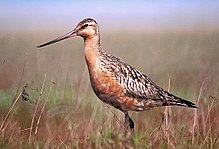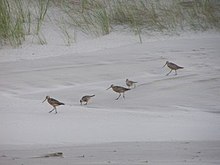Common godwit
| Common godwit | ||||||||||
|---|---|---|---|---|---|---|---|---|---|---|

Common godwit |
||||||||||
| Systematics | ||||||||||
|
||||||||||
| Scientific name | ||||||||||
| Limosa lapponica | ||||||||||
| ( Linnaeus , 1758) |




The bar-tailed godwit ( Limosa lapponica ) is a species of bird from the family of the Waders (Scolopacidae). In the Central European Wadden Sea, the common godwit is a regular and frequent migrant and winter visitor. Especially on the Central European coast, some birds also spend the summer. The global woodcock is threatened and was placed on the International Red List of Endangered Species in 2015 .
features
The godwit is very similar in appearance to the godwit . However, it is a little smaller as its legs are a little shorter than those of this species of snipe. Their beak is a little shorter than that of the black godwit and is always raised. Woodcock reach a body length of 37 to 41 centimeters and weigh between 230 and 360 grams.
In the splendid plumage of the males the plumage is intense rust-red; that of the females, on the other hand, is somewhat duller and more reddish-brown in color on the neck, breast and front belly. In the plain dress , the plumage is pale light brown in both sexes.
Their beak is 10 centimeters long. With its help, the woodcock can pull worms, crabs and other creatures out of the sand or mudflats at low tide . In winter quarters, their weight can double through this food. The energy reserves are used for the return flight to their breeding area.
distribution
The common woodcock is a breeding bird of the humid arctic tundra and is distributed from the northern edge of the forest zone in Lapland over Eurasia to western Alaska . There are five major breeding areas:
- the north of Fennos Scandinavia, the north of the White Sea area and the Kanin Peninsula
- the area from the Jamal Peninsula to the mouth of the Anabar
- the area from the mouth of the Lena to Tschaunbucht
- the territory of the Anadyr Liman and the southern part of the Chukchi Peninsula
- the north and west of Alaska.
In the Wadden Sea of Central Europe, the common woodcock can be seen in flocks of tens of thousands of birds when they move to their winter quarters in Western Europe and the Atlantic coast of Africa. Wetlands International classifies this region as the most important resting place in Europe, because the majority of the nominate form and the western population of the subspecies Limosa lapponica taymyrensis gather here at different times of the year . They stay there mainly from July to October and from late March to mid-May. Common woodcock overwinter in the Middle East and even in New Zealand .
Due to the great distance that they cover on their way to the winter quarters, they are long-distance migrants . In 2007, the 11,506-kilometer non-stop flight (200 hours) of a common godwit named "E7" from Alaska across the Pacific to New Zealand was detected with the help of a mini-transmitter. So far the longest documented non-stop flight of a bird. In New Zealand, where the birds that hibernate there from September to March, are known as the bar-tailed godwit . The return flight will begin with stops over the Yellow Sea , Japan and Kamchatka . Here, too, a distance of 11,026 kilometers is covered non-stop in nine days until the first stopover is made. The birds do not use the shortest linear distance for this stage, which would be only 9,575 kilometers.
Most of the common woodcock begin their trans-Pacific flight in the Yukon-Kuskokwim Delta in western Alaska, one of the largest river deltas on earth. The food supply is very rich there in summer and there are few predators. The birds can acquire a reserve of energy for the long flight.
The breeding birds of Fennoscandinavia and the European part of Russia as far as the Kanin Peninsula overwinter in Western Europe. Their wintering quarters extend from the southern North Sea, Great Britain and Ireland to the Atlantic coast of Portugal and southern Spain.
habitat
Woodcock breed in boggy places in the moss and strauchtundra as well as in swampy heaths of the willow and birch belt near the tree line. Outside of the breeding season, it can be found on fine sandy areas of the mudflats, flat coasts, estuaries and sea bays. It can also be observed on mud flats and, in small numbers, on the muddy banks of inland waters. It is much less common than the godwit to see inland.
Way of life
The food acquisition of the woodcock on the coast depends on the tide and at low tide they are also active at night. They mainly look for their food in shallow water. The common woodcock reach sexual maturity after the second or third year of life. The nest is a shallow, scraped-out hollow. The clutch consists of three to four eggs. Both parent birds are involved in the incubation. The breeding season is twenty to twenty-one days.
Inventory development
In 2015 the species was added to the International Red List as endangered worldwide.
The common woodcock is one of the species that will be particularly hard hit by climate change. A research team that, on behalf of the British environmental authority and the RSPB, examined the future development of the distribution of European breeding birds on the basis of climate models, assumes that by the end of the 21st century the common woodcock will disappear completely in its current European range. In terms of size, the distribution area will be reduced by 75 percent. According to these forecasts, suitable habitats will be limited to the south of Novaya Zemlya and the adjacent extreme northeast of Russia. Currently, these regions of the species do not yet offer suitable habitats.
supporting documents
literature
- Hans-Günther Bauer, Einhard Bezzel and Wolfgang Fiedler (eds.): The compendium of birds in Central Europe: Everything about biology, endangerment and protection. Volume 1: Nonpasseriformes - non-sparrow birds. Aula-Verlag Wiebelsheim, Wiesbaden 2005, ISBN 3-89104-647-2 .
- Peter Colston , Philip Burton: Limicolen - All European wader species, identifiers, flight images, biology, distribution. BlV Verlagsgesellschaft, Munich 1989, ISBN 3-405-13647-4
- Simon Delany, Derek Scott, Tim Dodman, David Stroud (Eds.): An Atlas of Wader Populations in Africa and Western Eurasia. Wetlands International , Wageningen 2009, ISBN 978-90-5882-047-1 .
Web links
- Limosa lapponica in the endangered Red List species the IUCN 2008. Posted by: BirdLife International, 2008. Accessed January 31 of 2009.
- Videos, photos and sound recordings of Limosa lapponica in the Internet Bird Collection
- Sissi Stein-Abel: Heralds of spring on the long haul. In New Zealand, the arrival of the well-conditioned bells is celebrated with the ringing of bells. In: Berliner Zeitung . September 15, 2007, accessed June 10, 2015 .
- USGS - Transmittered Pfuhlschnepfen Maps and background information on the flight of "E7"
- Feathers of the common woodcock
Individual evidence
- ↑ NABU press release | No 143/16 | December 8, 2016 NABU: Newly discovered and already endangered - Global Red List of Endangered Bird Species
- ↑ Delany et al., P. 291
- ↑ Delany et al., P. 295
- ↑ Yudhijit Bhattacharjee in National Geographic Germany , March 2018, p. 46
- ↑ science.orf.at ( page no longer available , search in web archives ) Info: The link was automatically marked as defective. Please check the link according to the instructions and then remove this notice.
- ↑ Bauer et al., P. 474
- ↑ Colston et al., P. 179
- ↑ Bauer et al., P. 474
- ↑ NABU press release | No 143/16 | December 8, 2016 NABU: Newly discovered and already endangered - Global Red List of Endangered Bird Species
- ^ Brian Huntley, Rhys E. Green, Yvonne C. Collingham, Stephen G. Willis: A Climatic Atlas of European Breeding Birds , Durham University, The RSPB and Lynx Editions, Barcelona 2007, ISBN 978-84-96553-14-9 , P. 192



